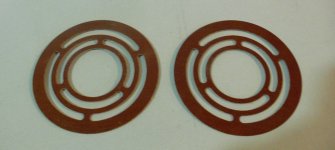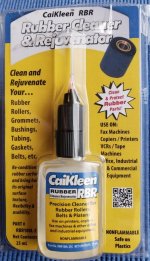Just for the clarity of terminology: What you call a tissue washer is also called a spider nowadays.
Regards
Charles
Regards
Charles
Just for the clarity of terminology: What you call a tissue washer is also called a spider nowadays.
Regards, Charles
Lost in Translation, Charles. 🙂
i have some unused tweeters from vifa and seas, all neo magnets, where the magnetic oils has harden and the domes can no longer move. some day i will try to clean the voice coils and the magnet gaps
i have some unused tweeters from vifa and seas, all neo magnets, where the magnetic oils has harden and the domes can no longer move. some day i will try to clean the voice coils and the magnet gaps
There is nothing difficult. When the old Seas H254 was brought to me, I easily disassembled, cleaned the old ferromagnetic fluid, poured the new one into the slot and easily assembled the tweeter.
true, but i guess it is important to have the correct viscosity, which i do not know for these drivers
i can leave out the oil too, but i guess fs is rather high for these tweeters and peaky impedance curves shure will make the crossovers bigger then wanted
i can leave out the oil too, but i guess fs is rather high for these tweeters and peaky impedance curves shure will make the crossovers bigger then wanted
JFYI: "corrugated treated cloth centering disks and cups" have been called "spiders" most of the time and "suspension" sometimes for the last 60 years or so, in English.Lost in Translation, Charles. 🙂
Punched phenolic "spiders" lost favour in the 40´s so when the word is used today nobody thinks of them ... except maybe in RadioMuseum.org
true, but i guess it is important to have the correct viscosity, which i do not know for these drivers
i can leave out the oil too, but i guess fs is rather high for these tweeters and peaky impedance curves shure will make the crossovers bigger then wanted
It is sold to a single viscosity, without using it, the sound pressure will increase by 2-3 dB.
I've been noticing for several years now that some woofers with rubber surrounds
end up having the spiders with significant sag, about 1/8". This was on all the SPICA
TC-50 woofers I have, 6 of them. I also see it on Celestion SL6 s both in a set. I'm
not sure what these are made from, the later SPICA woofers might have gone to PVC.
Anyone tried CaiKLeen?: Is there a chemist in the group?
Also, I once used WD40 on some rubber household parts that were sticking only to
find that the rubber expanded, probably due to the solvents. I wonder if this might
work to expand and soften those "rubber" surrounds. A last resort I suppose.
end up having the spiders with significant sag, about 1/8". This was on all the SPICA
TC-50 woofers I have, 6 of them. I also see it on Celestion SL6 s both in a set. I'm
not sure what these are made from, the later SPICA woofers might have gone to PVC.
Anyone tried CaiKLeen?: Is there a chemist in the group?
Also, I once used WD40 on some rubber household parts that were sticking only to
find that the rubber expanded, probably due to the solvents. I wonder if this might
work to expand and soften those "rubber" surrounds. A last resort I suppose.
Attachments
Last edited:
I usually replace the hardened surrounds, but I have heard of people using oil of wintergreen to restore rubber surrounds..but it is toxic when ingested, so you wouldn't want to use it where children or pets might get in contact with it.
I think any petroleum based rubber treatment is probably only temporary anyway.
I think any petroleum based rubber treatment is probably only temporary anyway.
I've tried several treatments including wintergreen oil, brake fluid, Rubber Renew, etc. All temporary at best. New surrounds were the only solution for me except for treated cloth surrounds. I have stripped and retreated them with the dissolved butyl rubber from RoyC.
I bought a jar of pure wintergreen oil for this a few years ago but have not tried it. The heat and exposure required would likely be a problem on an assembled speaker.
The Celestion SL6, 6i, and 700 have a split surround made of two different
materials so a treatment would be best.
We've discussed Wintergreen oil in the past, here's a Youtube video about it:
materials so a treatment would be best.
We've discussed Wintergreen oil in the past, here's a Youtube video about it:
This is interesting, I didn't understand what some of the components of
the soak were but I'm going to watch it again to see if I catch it:
the soak were but I'm going to watch it again to see if I catch it:
One possibility could be to use a UV heat source, and create a mask to keep the heat applied only to the area that is intended to be flexible, and not the part that has adhesive.
Someday I’ll have more time to experiment with that…
Someday I’ll have more time to experiment with that…
This was the go-to for treating capstan pucks on reel to reel and broadcast cart machines for decades. I don't recall it being particularly gentle or effective. More of a last stand fix to squeek by until replacement parts arrived. Very strong solvents.Another one from MG Chemicals:
- Home
- Loudspeakers
- Multi-Way
- Rubber Surrounds Hardening With Age


